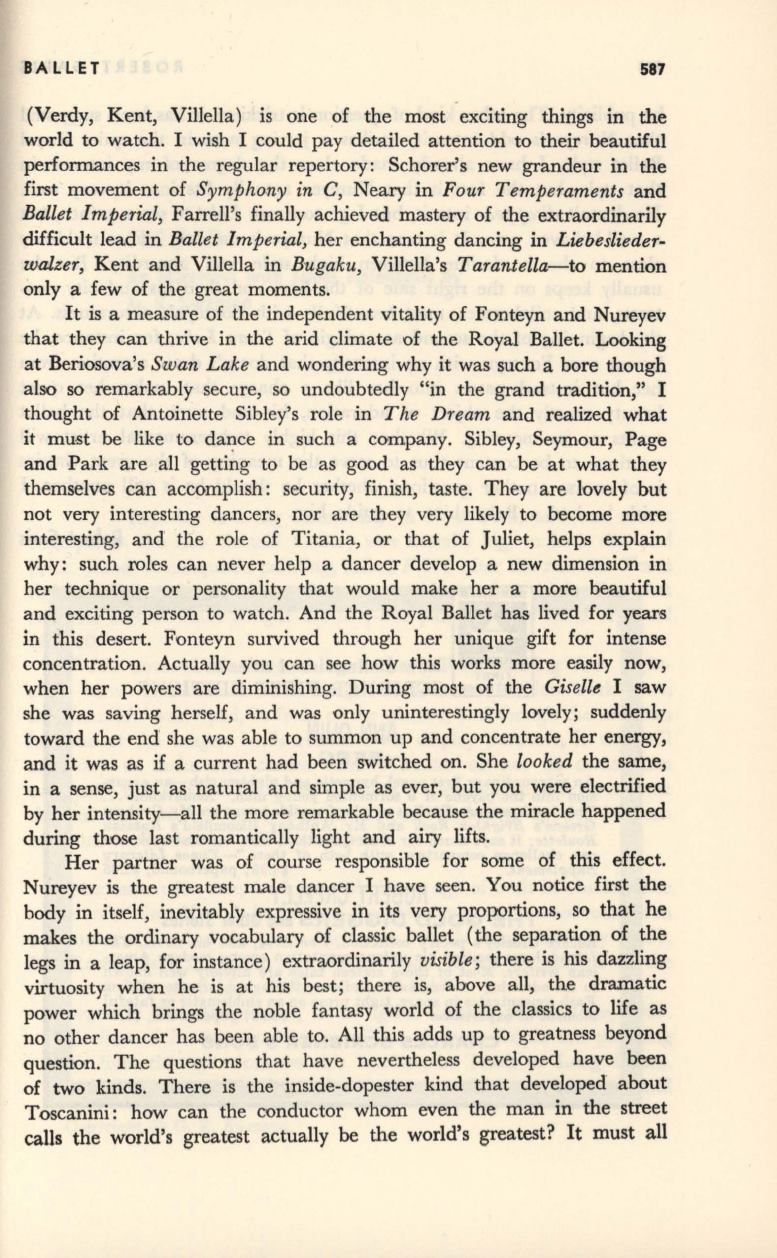
BALLET
587
(Verdy, Kent, Villella) is one of the most exciting things in the
world to watch. I wish I could pay detailed attention to their beautiful
performances in the regular repertory: Schorer's new grandeur in the
first movement of
Symphony in C,
Neary in
Four Temperaments
and
Ballet Imperial,
Farrell's finally achieved mastery of the extraordinarily
difficult lead in
Ballet Imperial,
her enchanting dancing in
Liebeslieder–
walzer,
Kent and Villella in
Bugaku,
Villella's
Tarantella-to
mention
only a few of the great moments.
It is a measure of the independent vitality of Fonteyn and Nureyev
that they can thrive in the arid climate of the Royal Ballet. Looking
at Beriosova's
Swan Lake
and wondering why it was such a bore though
also so remarkably secure, so undoubtedly "in the grand tradition," I
thought of Antoinette Sibley'S role in
The Dream
and realized what
it must be like to daI?-ce in such a company. Sibley, Seymour, Page
and Park are all getting to be as good as they can be at what they
themselves can accomplish: security, finish, taste. They are lovely but
not very interesting dancers, nor are they very likely to become more
interesting, and the role of Titania, or that of Juliet, helps explain
why: such roles can never help a dancer develop a new dimension in
her technique or personality that would make her a more beautiful
and exciting person to watch. And the Royal Ballet has lived for years
in this desert. Fonteyn survived through her unique gift for intense
concentration. Actually you can see how this works more easily now,
when her powers are diminishing. During most of the
Giselle
I saw
she was saving herself, and was only uninterestingly lovely; suddenly
toward the end she was able to summon up and concentrate her energy,
and it was as if a current had been switched on. She
looked
the same,
in a sense, just as natural and simple as ever, but you were electrified
by her intensity-all the more remarkable because the miracle happened
during those last romantically light and airy lifts.
Her partner was of course responsible for some of this effect.
Nureyev
is
the greatest male dancer I have seen. You notice first the
body in itself, inevitably expressive in its very proportions, so that he
makes the ordinary vocabulary of classic ballet (the separation of the
legs in a leap, for instance) extraordinarily
visible;
there is his dazzling
virtuosity when he is at his best; there is, above all, the dramatic
power which brings the noble fantasy world of the classics to life as
no other dancer has been able to. All this adds up to greatness beyond
question. The questions that have nevertheless developed have been
of two kinds. There is the inside-dopester kind that developed about
Toscanini: how can the conductor whom even the man in the street
calls the world's greatest actually be the world's greatest? It must all


